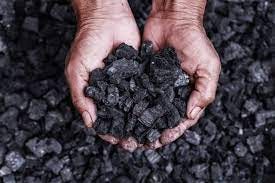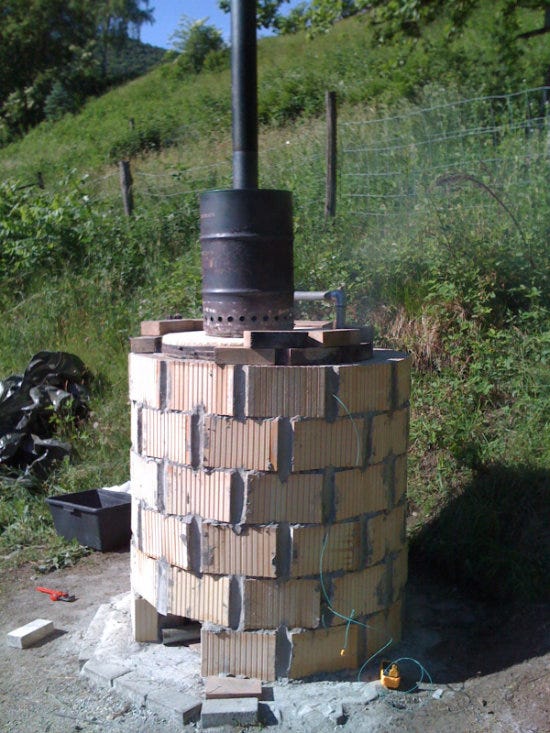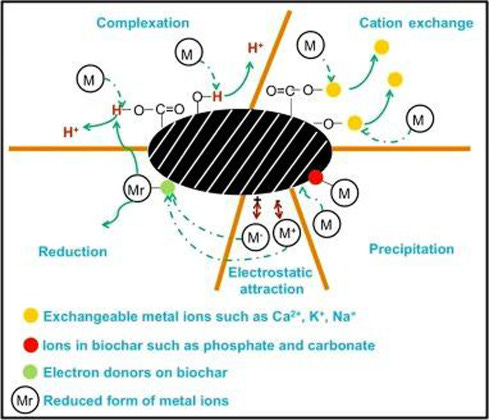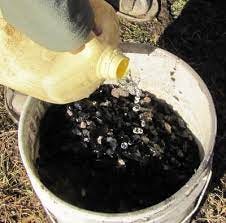Exploring the Potential and Pitfalls of Biochar for Soil Amendment
The humble carbon form that has exploded across YouTube
Ask any YouTube homesteader, and biochar is the missing ingredient on most sites— biochar has this long history of making terrible soils the richest in the world, and all we need is to apply that technology innew places. Biochar is described as the secret hack to agriculture, the missing piece that for some reason was lost and no one can explain why it never traveled the world. So let’s talk about it. Biochar. What is the difference between that and char?
Biochar is pyrogenic carbon, and unlike charcoal, biochar is heated to higher temperatures. Not only is it something that we have seen in places with poor soil, but it’s also one of the oldest practices we have human records of—The oldest record of the use of biochar by men is drawings in the Grotte Chauvet, which are older than 38,000 years.1 Despite the fact we are talking about using it in agriculture, it’s been a core piece of how we have existed on the earth—only biochar was clean enough to smelt metals at such high temperatures. It is a key component in gunpowder, discovered in China in the ninth century. And, of course, we could talk about the Terra Preta of the Amazon; poor soils that were made significantly better through management and– you guessed it– biochar.2
Without going too deep into the Terra Preta, it’s worth talking about what the evidence from these sites that were managed for thousands of years showed. Sites with biochar had higher pH values, and couldn’t be delivered to the soil simply by slash and burn, and evidence actually suggests the slash and burn, or swidden agriculture, which we talked about with the Maya, came after.
So basically, it is a super-pure charcoal. Most biomass can make biochar, and this is done by heating the material in the absence of oxygen at temperatures of 600 to 950 degrees Fahrenheit. That’s the bare bones of it. The amount and the quality of the products that you may be trying to get out of the process— the biochar, or some of the other materials that are sometimes of interest like tars and oils, depend heavily on that higher temperature as well as some more complex variables like pressure and heating rate.
Calorific value, hardness, compressive strength, surface area, electrical resistivity, and reactivity are all measured to qualify its status. So the temperatures are important, right? And while we can’t control our backyard biochar setup pressure and heating rates, those are made less important by getting to that higher temperature and holding it there. It’s not ideal for getting those secondary products, the tars, and so on, but we’re not interested in those right now, and our goal is to reduce the amount of hydrocarbons in the biochar, reducing impurities that might be good for charcoal— tar and oils like to burn— and that’s not what we’re trying to get here. However, studies show that the higher the temperature we make the biochar, the less water retention it has afterward.
The burning process also, if it wasn’t already clear, is breaking the bonds of the biomass. In this breaking process, these broken bonds don’t adhere to new things, and this is what gives biochar its unique, to use the scientific term, chemisorption properties. Chemisorption functions like magnets, basically, but on a molecular scale. It’s how rust forms, as the reaction on the exposed surface of iron creates a distinct bond.
At this point, we’ve talked about how biochar is heated, why it’s different than regular charcoal, and how different processes can impact the quality of biochar, although we’re not jumping deep into that at this moment. After we’ve cooked it, we need to let it cool down before we can do anything with it, not just so we can keep our hands safe, but exposing it to oxygen will, you know, burn it up.
In terms of actual facilities for making biochar, you can make it as easy or as complicated as you want. I have a little metal saucepan from a hotel that has a lid that I toss in my wood stove, an idea I got from edible acres, that makes a gallon or so of biochar at a time. Some folks will use burn barrels, and there are some pretty impressive designs, such as the Anila-stove, which maximizes heat production by also burning the gasses from the biochar production.
Biochar can be used for a ton of things, from heating homes to being the byproduct of other products, whether it’s wood vinegar from the smoke or the tars or oils we covered before or even being used for air purification or water filtration. But we’re not here to talk about those things, let’s talk about biochar as a soil amendment. Its most commonly known fact is that it raises pH & it’s a carbon sink, and we know it has improved soils in the past. But what else?
Being a porous thing we’re adding to our soil with the chemisorption properties, it’s great at sucking in water instead of letting it run off. While we don’t know why this is the case as of yet, evidence has shown that it’s most effective in this capacity when incorporated into coarse-textured soils. If you recall from way back when we did our soil articles, sand is much more coarse and larger than clay, and the spaces between the two big sand granules is why water flows through sandy soils so easily, while clay is tiny and water struggles to break through. Biochar has been shown to increase water retention by up to 20% in these sandier soils.3 These increases are more prominent in biochars that were heated to higher temperatures.
That doesn’t mean everyone should add biochar, especially if they have sandy soils. These effects occur not always in the same magnitude and depend on the pyrolysis process and the feedstock. Not less important is the soil itself, the same biochar applied to different soils can have different impacts. Physical, chemical, and biological properties of soil and biochar influence each other. For example, the cation exchange capacity, which is important for the availability of nutrients, is low in freshly produced biochars and increases only through oxidative processes in soils.4 Therefore, the soil-improving facts cannot be generalized. On some poor soils, the increase in biomass yield can be several hundred percent. But there are also a few reports on experiments, where plant growth was suppressed by biochar. There could be several reasons for this, from the pH change we had talked about, which could suppress some acidophilic microbial communities, which are useful for plant growth, or a freshly produced biochar can absorb most available nutrients and induce a temporary nutrient deficiency.5
Because of its high surface area, and cation exchange capacity, especially early on when it’s still low, it has the surface capacity to absorb nutrients, but its low CEC– cation exchange capacity, limits its ability to fully absorb those nutrients until it’s been oxidized. That said, again this might be a refresher, high pH soils have higher CEC, so when we talk about it being low, it’s low for something at that pH, not low in general. The statistical average for biochar, and we’re talking obviously in pretty loose terms here, is around 15. For context, the average loam, which is basically what people want for soil, is between 15 and 30, so it’s right in the ballpark where you’d be happy, even at its low end. Fully oxidized biochar, however, can have a CEC often over 50 and has been documented over 200.6
So, to circle back, the CEC is low for biochar, but not low in general, meaning, when added to poor soils, it can quite easily absorb nutrients from the soil, making the surrounding soil poorer. And that’s where the piss jugs come in. Soaking the biochar in nutrient-rich liquids is a fantastic way to “charge” the soil. And urine is full of great stuff… for your plants.
Charging biochar is fairly simple, and it doesn’t need to be urine. It can be compost liquid, fish emulsion, and more. Soak the biochar in the material for a few weeks, and take it out. It can be as simple or as complicated as you want to make it.
Biochar can also be used for contaminated site cleanups, but it can also basically cause things to, well, get mixed up and draw pollutants closer to root systems, and so on. This could be a great solution for soil remediation, which I think would be cool. One thing that doesn’t get talked about much around biochar use is that, even if we don’t understand how it works quite yet, repeated studies have shown that biochar also increases the biological nitrogen fixation of leguminous plants and reduces the amount of nitrous oxide emissions from soils, which is an incredibly potent greenhouse gas– almost 300x times Carbon Dioxide.7
And biochar can be made out of any biomass, but, they’re not all equal. The common theme seems to be that the best biochar materials tend to be those that reflect the site they’ll be used on. So, if you’re in a mature forest, hardwood biochar is best. And to make it even more complicated, softwoods have shown to hold water better, even if they’re otherwise less “good” at other biochar stuff, so using both might make sense, based on the site itself.8 If you’re in pasture or prairie, corn stalks or something similar would be ideal. There doesn’t seem to be any evidence for why this is the case, but repeated tests have shown this to be fairly consistent.
The simple answer is we don’t know a whole lot at this point about the interactions between biochar and other soil materials; whether that’s compost, the existing minerals in the soil, the plant choices on the site, and a million other things. Plenty of resources point to examples of where biochar has reduced soil health, and some evidence suggests that in some cases the benefits of biochar only last a few years.9, 10 Further, evidence has shown that in long-term studies, biochar has increased the microbial activity in forests but decreased the biomass turnover time, which means that carbon is cycling back out of the earth more quickly.11,12
The point is, that there are no hard and fast rules around biochar use. We are embarrassingly lacking in knowledge on its use, but there are some pretty clear examples when it’s best. Sandy, exploited soils, specifically regions where there’s low pH and repeated clearcutting or tree plantations. But it’s important to pay attention to the landscape and to make sure your biochar isn’t drawing nutrients out of the soil. The point here should be that biochar isn’t a magic fix, and in some cases can be damaging. In some cases, there’s even evidence of using too much and causing problems, even when it’s properly charged.
In a study in 2015, researchers applied significantly different volumes of biochar to a cornfield and there was no change across the entire site; it was like they had done nothing.13 And they don’t have a clue why. And I do want to bring up again that biochar is great at accumulating pollutants and heavy metals, and drawing them closer to your root systems if they’re in the soil isn’t going to be good for the folks eating said plants.14
If I want to use it, how much should you use, and should you bury it or ground it up, or what, exactly? Part of the reason I didn’t cover this throughout this piece is that the answer is, unsurprisingly, *complicated*. Generally, when we measure stuff like biochar that we’re applying into the soil, we are trying to measure the volume. With, say, lime, we can just say we have x amount of square feet at a certain pH and we want to get it up to another amount, we can just use the square foot times the pH change to accurately apply the mineral. With biochar, since we’re adding it to the soil, we need to think about the depth, and that depth varies depending on your interests and needs. Generally speaking, and of course, as we’ve covered—it’s complicated—but a standard spot to work from is around 20 pounds per acre, which you can work back if you’re working on a couple of hundred square feet, and you’ll want to get that into the soil at least 5-10 inches, if possible. If you’re not capable of doing that, grinding it and applying it with compost or another soil amendment to mix it in so it doesn’t just blow away will help get it into the soil.
There’s much more research to be done in the area of biochar, and really that work has just begun. In reality, within the next decade, this piece will likely largely be out of date as new information is discovered and we can dial in biochar for site-specific needs. Until then, we can operate from an honest, pragmatic appreciation for this ancient technology.
If you’ve enjoyed this piece, which is equal to a 11-page chapter, of (so far) a 927-page book with 603 sources, you can support our work in a number of ways. The first is by sharing this article with folks you think would find it interesting. Second, you can listen to the audio version of this episode, #122, of the Poor Proles Almanac wherever you get your podcasts. Suppose you’d like to financially support the project, and get exclusive access to our limited paywalled content. In that case, you can become a paid subscriber on Substack or Patreon, which will both give you access to the paywalled content and in the case of Patreon, early access to the audio episodes as well.
https://meyer-kohlstock.de/Biochar.pdf
https://biochar.info/?p=en.terra_preta
Burrell, L. D., Zehetner, F., Rampazzo, N., Wimmer, B., & Soja, G. (2016). Long-term effects of biochar on soil physical properties. Geoderma, 282, 96–102. https://doi.org/10.1016/j.geoderma.2016.07.019
Kharel, G., Sacko, O., Feng, X., Morris, J. R., Phillips, C. L., Trippe, K., Kumar, S., & Lee, J. W. (2019). Biochar surface oxygenation by ozonization for super high cation exchange capacity. ACS Sustainable Chemistry & Engineering, 7(19), 16410–16418. https://doi.org/10.1021/acssuschemeng.9b03536
Meyer-Kohlstock, D. (2009). Biochar- A Survey (dissertation).
Munera-Echeverri, J. L., Martinsen, V., Strand, L. T., Zivanovic, V., Cornelissen, G., & Mulder, J. (2018). Cation exchange capacity of biochar: An urgent method modification. Science of The Total Environment, 642, 190–197. https://doi.org/10.1016/j.scitotenv.2018.06.017
Alho, C. F., Cardoso, A. da, Alves, B. J., & Novotny, E. H. (2012). Biochar and soil nitrous oxide emissions. Pesquisa Agropecuária Brasileira, 47(5), 722–725. https://doi.org/10.1590/s0100-204x2012000500013
Werdin, J., Fletcher, T. D., Rayner, J. P., Williams, N. S. G., & Farrell, C. (2020). Biochar made from low density wood has greater plant available water than biochar made from high density wood. Science of The Total Environment, 705, 135856. https://doi.org/10.1016/j.scitotenv.2019.135856
Rees, F., Simonnot, M.-O., & Morel, J. L. (2015). Mechanisms of soil pH regulation by biochar amendments and consequences for biochar long-term effects. Conference: ISMOM 2015 - Soil Interfaces for Sustainable Development.
Werdin, J., Fletcher, T. D., Rayner, J. P., Williams, N. S. G., & Farrell, C. (2020a). Biochar made from low density wood has greater plant available water than biochar made from high density wood. Science of The Total Environment, 705, 135856. https://doi.org/10.1016/j.scitotenv.2019.135856
Pei, J., Li, J., Mia, S., Singh, B., Wu, J., & Dijkstra, F. A. (2021). Biochar aging increased microbial carbon use efficiency but decreased biomass turnover time. Geoderma, 382, 114710. https://doi.org/10.1016/j.geoderma.2020.114710
Erb, K.-H., Fetzel, T., Plutzar, C., Kastner, T., Lauk, C., Mayer, A., Niedertscheider, M., Körner, C., & Haberl, H. (2016). Biomass turnover time in terrestrial ecosystems halved by land use. Nature Geoscience, 9(9), 674–678. https://doi.org/10.1038/ngeo2782
Sorensen, R. B., & Lamb, M. C. (2016). Crop yield response to increasing biochar rates. Journal of Crop Improvement, 30(6), 703–712. https://doi.org/10.1080/15427528.2016.1231728
Xiang, L., Liu, S., Ye, S., Yang, H., Song, B., Qin, F., Shen, M., Tan, C., Zeng, G., & Tan, X. (2021). Potential hazards of biochar: The negative environmental impacts of biochar applications. Journal of Hazardous Materials, 420, 126611. https://doi.org/10.1016/j.jhazmat.2021.126611






